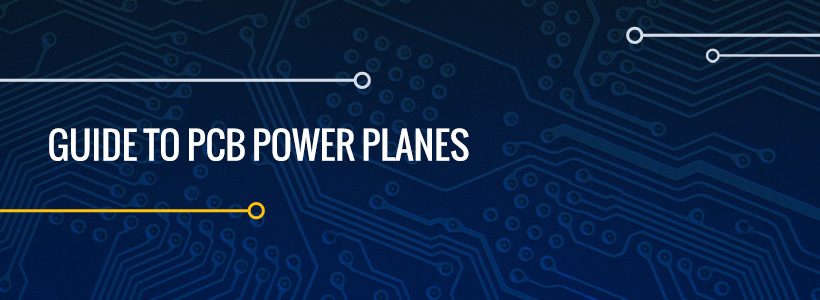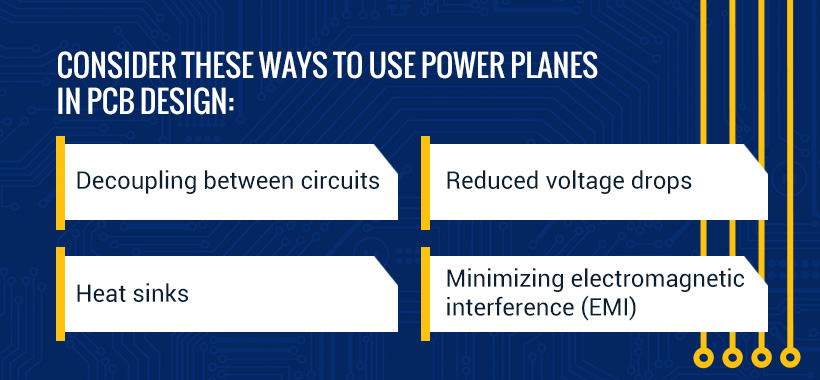Updated on January 15, 2025
Table of Contents
- What Is a Power Plane in a PCB?
- Uses for PCB Power Planes
- PCB Power Plane Design Best Practices
- Frequently Asked Questions
Printed circuit boards (PCBs) require power supplies, and power planes ensure even power distribution. Power planes also deliver several other significant benefits to PCBs, such as noise reduction and heat dissipation. Employing power planes can enhance PCB performance and ensure board integrity. Keep reading to learn more about power planes, including best practices for implementing them in your PCB design.
What Is a Power Plane in a PCB?
PCB power planes are entire conductive layers of a PCB that supply the power for the PCB. These planes are connected to the power source and distribute power across the board for other layers to access. Ground planes provide the return path after the power has gone through the components of the PCB.
Typically, PCBs with three or more layers have at least one dedicated power plane. They are usually designed with an even number of layers to prevent the final product from warping and twisting.
Benefits of power planes include:
- Shorter return paths: As the entire plane is at the needed potential, the electrical path needed to supply power to a component is much shorter than that of alternate solutions.
- Improved current capacity: While traces often struggle to handle larger currents, especially when the trace is longer, power planes have greater current-carrying capacities. These greater capacities translate to lower operating temperatures, further preserving your board’s integrity.
- Power distribution: The key function of a power plane is to distribute power to a PCB. These components ensure constant power delivery and are easy to connect, making them a simple solution. Ultimately, power planes simplify power management and enhance overall performance.
Uses for PCB Power Planes
Power planes serve several purposes for PCBs. These components help protect your board and improve performance. Consider these ways to use power planes in PCB design:
- Decoupling between circuits: Teams commonly use planes rather than traces because planes provide better decoupling between circuits. When you have two planes that are close together and held at different potentials, they act as a small capacitor. Improved decoupling prevents noise and energy from spreading between circuits in the power supply.
- Reduced voltage drops: Power planes eliminate power routing complications and minimize voltage drops to ensure the board remains stable. Multiple planes for varying voltage levels simplify power management and enhance the overall design.
- Heat sinks: Power planes can help dissipate heat to prevent hot spots. The plane can distribute the heat across the board, and copper planes can specifically serve as heat sinks. High-power components will find the most use for this, as better heat dissipation translates to enhanced performance and reliability.
- Minimizing electromagnetic interference (EMI): Another use for power planes is shielding from EMI. These components can act as barriers to interference and reduce noise in sensitive circuits. Using power planes helps contain the electromagnetic field within the board and improves signal integrity for the entire system.
PCB Power Plane Design Best Practices
Before using a power plane in your PCB, it’s beneficial to understand the best practices for implementing this component. Relying on these strategies can help you maximize power plane impact. Power plane PCB best practices include the following:
- Provide multiple domains: Single-layer PCBs require a single power domain to supply identical voltage requirement components with power. Complex and dense designs use multiple domains for best practice. Multiple domains can help save space and ensure components have power, but you can experience EMC issues, greater noise, and crosstalk. Reliable manufacturers will separate analog and digital circuits to reduce possible negative effects or separate each power rail and skip the power plan for routing efficiency.
- Ensure proper symmetry: Proper symmetry is important when designing multi-layer PCBs. Power planes are critical for ensuring this symmetry. For example, you would use two internal power planes on a four-layer board to ensure symmetry. This strategy is especially beneficial for two-sided boards with mounted components on the top and bottom layers. You will need to rely on traces for PCB returns when using multiple power planes.
- Leverage cross-team tools and software: Collaboration is a best practice for much of the design process. Collaboration tools allow you to simulate and analyze designs to create the most efficient layout. Using cross-team software and tools allows you to set the correct layer dimensions, select the best materials, and stack up with the right design. Some layout software can also guide you through choosing sizes, types of vias, numbers, and locations.
- Create an appropriate via design: Vias are important for PCB power plane designs, and proper vias design ensures even power distribution. These components connect power planes across layers. Consider your current capacity to determine the best sizing and spacing. High-current paths often need multiple vias.
- Choose the right material: Material selection is a crucial part of the design phase — the right materials will optimize board reliability and performance. High-frequency designs often require low-loss materials. You will need to consider thermal properties and strategies for heat dissipation and ensure the material you choose can adhere to copper.
Frequently Asked Questions
Designing an efficient PCB layout can be time-consuming, but it is worth the dedication. Check out these frequently asked questions about PCB power planes to make the process simpler:
1. What Are Power Planes in PCB for?
PCB power planes are helpful for a variety of uses. You can use them to improve current capacity, distribute power evenly, create shorter return paths, prevent voltage drops, and enhance decoupling. These components can also help minimize EMI and act as heat sinks to prevent overheating.
2. How Many Power Planes Do I Need for PCB?
It’s best to keep an even number of layers to ensure symmetry. For example, a three-layer board would need one power plane, while a four-layer board would need two.
3. Which Layers Should Power Planes be on?
Power planes typically reside in the inner layers of a multi-layer PCB. It’s best to have an even number of layers, so the exact placement could vary, depending on whether you start with an even or odd number of layers. Additionally, if your design demands multiple voltage levels, you may need to split the power planes to isolate the various power domains.
Why Trust Millennium Circuits?
Since 2005, Millennium Circuits has been solving PCB complexities and helping teams across industries overcome challenges. We proudly serve industries including automotive, medical, power and energy, industrial equipment, datacom, defense, and telecom. Working with our experienced teams gives you access to comprehensive technical support and quality engineering services.
Meet Your Power Plane Printed Circuit Board Needs With Millennium Circuits
Millennium Circuits is your reliable PCB service provider. Contact our team to learn more about power planes or for assistance making design decisions for your PCBs.





